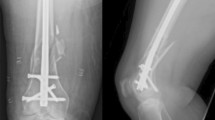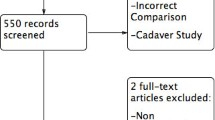Abstract
Background
Recent popularity of intramedullary nails over sliding hip screws for treatment of intertrochanteric fractures is concerning given the absence of evidence for clinical superiority for nailing yet the presence of reimbursement differences.
Questions/purposes
We describe the change in outcomes of both procedures across a 15-year span and address the role of reimbursements in the setting of shifting patterns in use.
Methods
A 5% sample of Medicare enrollees from 1993 to 2007 was used. Cohorts were generated along diagnostic and procedure codes. Trends in device use by hospital type, surgical times, and rate of revision surgeries were compared. Historic reimbursements were examined.
Results
Since 2005, intramedullary nail fixation has become the more common treatment in government, nonprofit, and for-profit hospitals. Before 1999, intramedullary nailing required 36 minutes longer to perform than plate-and-screw fixation on average, and had higher revision surgery rates (hazard ratio, 2.48; CI, 1.37–4.48) and 1-year mortality (hazard ratio, 1.42; CI, 1.01–1.99). These differences were not significant since 2000. Reimbursement differences have been consistently in favor of intramedullary nails.
Conclusion
Intramedullary nailing of intertrochanteric fractures has become as safe and efficient as the sliding hip screws, but has been more popular since 2006. Reimbursements were favorable for intramedullary nails in times of low and high use. These results argue against the reimbursement difference as the sole driving force for use of intramedullary nails.
Level of Evidence
Level III, therapeutic study. See Guidelines for Authors for a complete description of levels of evidence.





Similar content being viewed by others
References
Adams CI, Robinson CM, Court-Brown CM, McQueen MM. Prospective randomized controlled trial of an intramedullary nail versus dynamic screw and plate for intertrochanteric fractures of the femur. J Orthop Trauma. 2001;15:394–400.
Anglen JO, Weinstein JN; American Board of Orthopaedic Surgery Research Committee. Nail or plate fixation of intertrochanteric hip fractures: changing pattern of practice. A review of the American Board of Orthopaedic Surgery Database. J Bone Joint Surg Am. 2008;90:700–707.
Aros B, Tosteson AN, Gottlieb DJ, Koval KJ. Is a sliding hip screw or IM nail the preferred implant for intertrochanteric fracture fixation? Clin Orthop Relat Res. 2008;466:2827–2832.
Barton TM, Gleeson R, Topliss C, Greenwood R, Harries WJ, Chesser TJ. A comparison of the long gamma nail with the sliding hip screw for the treatment of AO/OTA 31-A2 fractures of the proximal part of the femur: a prospective randomized trial. J Bone Joint Surg Am. 2010;92:792–798.
Bhandari M, Schemitsch E, Jönsson A, Zlowodzki M, Haidukewych GJ. Gamma nails revisited: gamma nails versus compression hip screws in the management of intertrochanteric fractures of the hip: a meta-analysis. J Orthop Trauma. 2009;23:460–464.
Bozic KJ, Jacobs JJ. Technology assessment and adoption in orthopaedics: lessons learned. J Bone Joint Surg Am. 2008;90:689–690.
Forte ML, Virnig BA, Eberly LE, Swiontkowski MF, Feldman R, Bhandari M, Kane RL. Provider factors associated with intramedullary nail use for intertrochanteric hip fractures. J Bone Joint Surg Am. 2010;92:1105–1114.
Forte ML, Virnig BA, Kane RL, Durham S, Bhandari M, Feldman R, Swiontkowski MF. Geographic variation in device use for intertrochanteric hip fractures. J Bone Joint Surg Am. 2008;90:691–699.
Grilli R, Guastaroba P, Taroni F. Effect of hospital ownership status and payment structure on the adoption and use of drug-eluting stents for percutaneous coronary interventions. CMAJ. 2007;176:185–190.
Haidukewych GT, Israel TA, Berry DJ. Reverse obliquity fractures of the intertrochanteric region of the femur. J Bone Joint Surg Am. 2001;83:643–650.
National Cancer Institute. Surveilance Epidemiology and End Results. Available at: http://seer.cancer.gov/. Accessed October 8, 2012.
Palm H, Jacobsen S, Sonne-Holm S, Gebuhr P; Hip Fracture Study Group. Integrity of the lateral femoral wall in intertrochanteric hip fractures: an important predictor of a reoperation. J Bone Joint Surg Am. 2007;89:470–475.
Papasimos S, Koutsojannis CM, Panagopoulos A, Megas P, Lambiris E. A randomised comparison of AMBI, TGN and PFN for treatment of unstable trochanteric fractures. Arch Orthop Trauma Surg. 2005;125:462–468.
Parker MJ, Handoll HH. Gamma and other cephalocondylic intramedullary nails versus extramedullary implants for extracapsular hip fractures in adults. Cochrane Database Syst Rev. 2010;9:CD000093.
Rogmark C, Spetz CL, Garellick G. More intramedullary nails and arthroplasties for treatment of hip fractures in Sweden. Acta Orthop. 2010;81:588–592.
Silber JH, Rosenbaum PR, Zhang X, Even-Shoshan O. Estimating anesthesia and surgical procedure times from medicare anesthesia claims. Anesthesiology. 2007;106:346–355.
Teno JM, Mitchell SL, Gozalo PL, Dosa D, Hsu A, Intrator O, Mor V. Hospital characteristics associated with feeding tube placement in nursing home residents with advanced cognitive impairment. JAMA. 2010;303:544–550.
Utrilla AL, Reig JS, Munoz FM, Tufanisco CB. Trochanteric gamma nail and compression hip screw for trochanteric fractures: a randomized, prospective, comparative study in 210 elderly patients with a new design of the gamma nail. J Orthop Trauma. 2005;19:229–233.
Whang PG, Lim MR, Sasso RC, Skelton A, Brown ZB, Anderson DG, Albert TJ, Hilibrand AS, Vaccaro AR. Financial incentives for lumbar surgery: a critical analysis of physician reimbursement for decompression and fusion procedures. J Spinal Disord Tech. 2008;21:381–386.
Zou J, Xu Y, Yang H. A comparison of proximal femoral nail antirotation and dynamic hip screw devices in trochanteric fractures. J Int Med Res. 2009;37:1057–1064.
Author information
Authors and Affiliations
Corresponding author
Additional information
One or more of the authors (FC) has received funding from the Clinical Research Training Program, a research program made possible through a public-private partnership supported jointly by the National Institutes of Health (NIH) and Pfizer Inc (through a grant to the Foundation for NIH from Pfizer Inc). One or more of the authors (FC, ZW, TB) also were supported in part by the Intramural Research Program of the National Institute of Arthritis and Musculoskeletal and Skin Diseases of the NIH.
All ICMJE Conflict of Interest Forms for authors and Clinical Orthopaedics and Related Research editors and board members are on file with the publication and can be viewed on request.
Clinical Orthopaedics and Related Research neither advocates nor endorses the use of any treatment, drug, or device. Readers are encouraged to always seek additional information, including FDA-approval status, of any drug or device prior to clinical use.
Each author certifies that his or her institution approved the human protocol for this investigation, that all investigations were conducted in conformity with ethical principles of research, and that informed consent for participation in the study was obtained.
This work was performed at the National Institute of Arthritis and Musculoskeletal and Skin Diseases, National Institutes of Health, Bethesda, MD, USA.
About this article
Cite this article
Chen, F., Wang, Z. & Bhattacharyya, T. Convergence of Outcomes for Hip Fracture Fixation by Nails and Plates. Clin Orthop Relat Res 471, 1349–1355 (2013). https://doi.org/10.1007/s11999-012-2694-8
Received:
Accepted:
Published:
Issue Date:
DOI: https://doi.org/10.1007/s11999-012-2694-8




